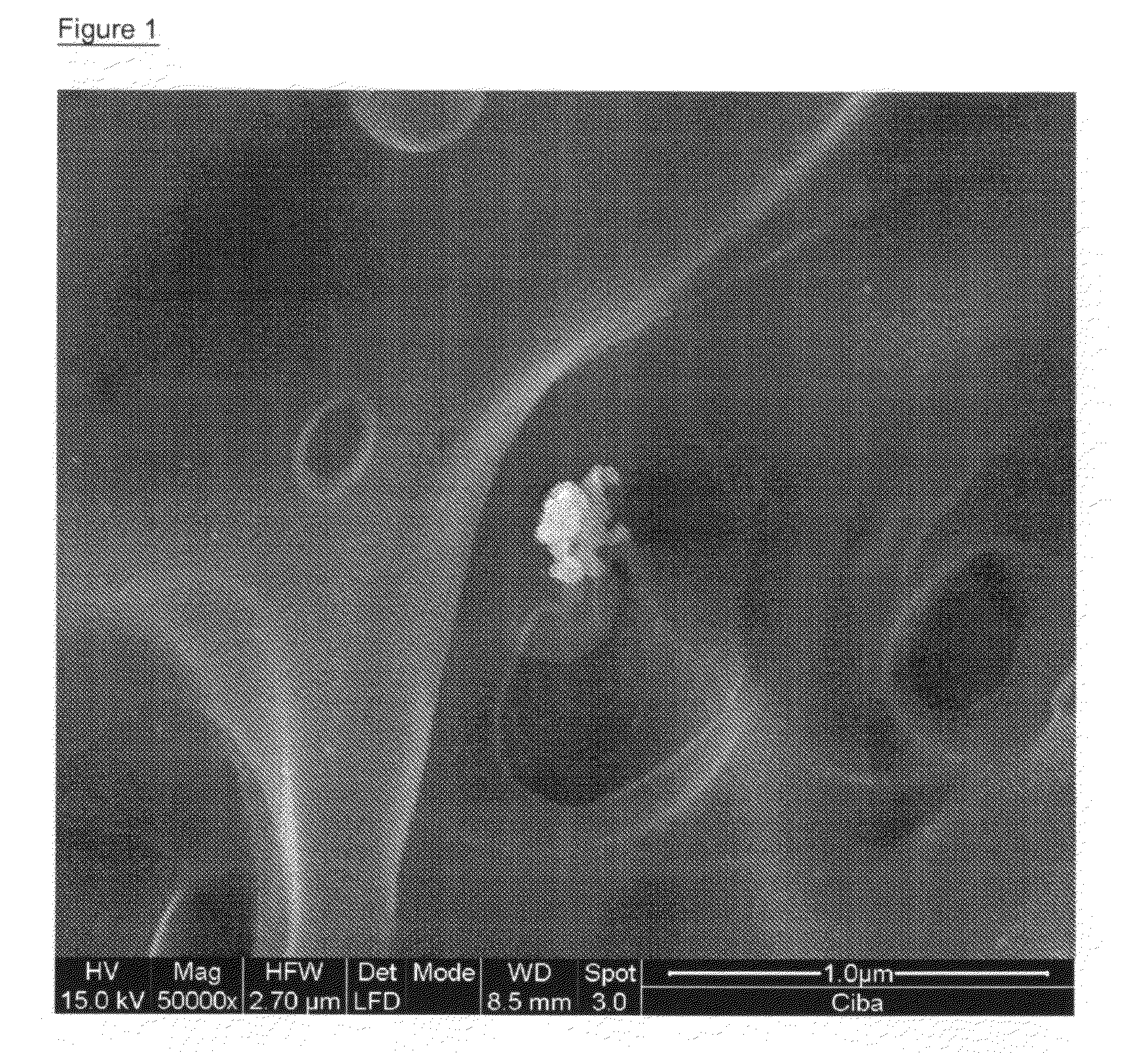Process for the preparation of an antimicrobial article
- Summary
- Abstract
- Description
- Claims
- Application Information
AI Technical Summary
Benefits of technology
Problems solved by technology
Method used
Image
Examples
example 1
Preparation of Silver Colloid in Presence of Polymer
[0076]Instruments used are 250 mL Erlemeyer glass tubes, magnetic stirrer, heat plate.
[0077]4 g of polyvinylpyrrolidone (Luvitec K40) are dissolved in 40 ml of NMP at 60° C. or 90° C. as indicated in table 1. At constant temperature, the silver salt identified in table 1 is added to the PVP-NMP solution as a solid, and the reaction mixture is stirred for 2 h. The colloidal dispersion obtained is directly employed as the silver additive in the below example 2.
[0078]Analysis: Particle size distribution and specific surface is detected using laser diffraction (Mastersizer® 2000 [Malvern]; see also: http: / / www.fritsch-laser.de / uploads / media / GIT_analysette—22.pdf; dispersion fluid: N-methylpyrrolidone). The content of colloidal silver and ionic silver in the mixture thus obtained is determined by titration: 0.1 m HCl (purchased from Aldrich) is used as titrant; an ion-selective electrode in respect to Ag / AgCl-(KCl 1 M) is used as a refe...
example 2
Membrane Preparation
[0080]70 ml of N-methylpyrolidone (NMP) are placed in a three-neck flask with agitator. Polyvinylpyrolidone (Luvitec® PVP 40 K; 6.0 g) is added, the mixture is heated to 60° C. and stirred until a homogeneous clear solution is obtained. The amount of silver educt required to reach the concentration shown in the below table 2 is added to 6 g of NMP and sonicated for 20 minutes; the suspension obtained is then added to the PVP solution and stirred until homogeneous. Polyethersulfone Ultrason® 2020 PSR (18 g) is added and stirring is continued until a viscous homogenous solution is obtained. The solution is degassed overnight at without heating (temperature of the mixture: 20-40° C.). After reheating to 70° C., a membrane is cast on a glass plate with a casting knife (wet thickness 200 μm) at room temperature and allowed to dry for 30 seconds before immersion in a water coagulation bath of 25° C. After 10 minutes of immersion, the membrane obtained is rinsed with ho...
example 3
Antimicrobial Performance of the Membrane
[0086]Testing is conducted against Escherichia coli and Staphylococcus aureus according to ASTM 2149. This test measures the antimicrobial activity of test samples by shaking aliquots of polymer film (cut into small pieces prior to testing) in a bacterial suspension with a bacteria concentration of ˜105 colony forming units (cfu) per ml in a total volume of 25 ml. Investigation of E. coli is conducted as double determination of aliquots of polymer film in 12.5 ml. The total contact time is 24 hours. The suspension is serially diluted before and after contact and cultured. The number of viable organisms in the suspension is determined and the percent reduction calculated based on initial counts or on retrievals from appropriate untreated controls. Results are compiled in the below table 3.[0087]Test strains: Escherichia coli (Ec) DSM 682 (ATCC 10536)[0088]Staphylococcus aureus (Sa) DSM 799 (ATCC 6538)
[0089]Test conditions / Sample parameters:[00...
PUM
| Property | Measurement | Unit |
|---|---|---|
| Fraction | aaaaa | aaaaa |
| Volume | aaaaa | aaaaa |
| Volume | aaaaa | aaaaa |
Abstract
Description
Claims
Application Information
 Login to View More
Login to View More - R&D
- Intellectual Property
- Life Sciences
- Materials
- Tech Scout
- Unparalleled Data Quality
- Higher Quality Content
- 60% Fewer Hallucinations
Browse by: Latest US Patents, China's latest patents, Technical Efficacy Thesaurus, Application Domain, Technology Topic, Popular Technical Reports.
© 2025 PatSnap. All rights reserved.Legal|Privacy policy|Modern Slavery Act Transparency Statement|Sitemap|About US| Contact US: help@patsnap.com


